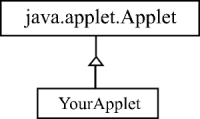If your Applet has any graphics, look at:
- repaint()
- update()
- paint()
Detailed Description:
"Once someone has written a Java tag within
their web page and loads the page,
the browser executes the .class file that represents a Java applet. All Java applets must
derive from or be a subclass of a class called Applet. This class is located in a package
called java.applet. So the formal long name is java.applet.Applet. The first applet has a
lower case 'a' and represents part of the package name, and the second Applet has an
uppercase 'A' that is the class name.
 This class provides the appropriate
structure that all Java applets must follow.
And specifically, it has unique methods in it that specify an interface that the web
browser assumes to be there. The key methods that one must implement or override are a
zero-argument constructor, or no-argument constructor, which could be the default
constructor, an init() method, a start() method, a stop() method, and a destroy() method.
These methods are executed in a specific sequence.
This class provides the appropriate
structure that all Java applets must follow.
And specifically, it has unique methods in it that specify an interface that the web
browser assumes to be there. The key methods that one must implement or override are a
zero-argument constructor, or no-argument constructor, which could be the default
constructor, an init() method, a start() method, a stop() method, and a destroy() method.
These methods are executed in a specific sequence.
Let's say that the constructor creates
whatever the applet needs to have as part of
its initialization. The init() method typically is executed to set up the graphical user
interface. The start() method is executed when the web age is shown. The stop() method
is executed when the web page is no longer shown. And the destroy() method is executed
when the applet is no longer needed and can be discarded.
In addition, if your applet does graphics
(draw lines and circles), you also need to
understand the relationship between repaint(), update(), and paint(). Briefly, repaint() is
executed by anything in your code if you wish to have the screen redrawn. Independent
of that, repaint() invokes a system thread called the screen updater. The screen updater's
job is to later call your update() method. The update() method's typical function is to
clear the background and call paint(). The paint() function then draws the screen and
does whatever graphics operations you wish to do for your applet. So realize that
asynchronous threads are operating here. Again, the sequence for painting is repaint()
starts up a secondary thread, the secondary thread calls update(), and update calls paint()."

